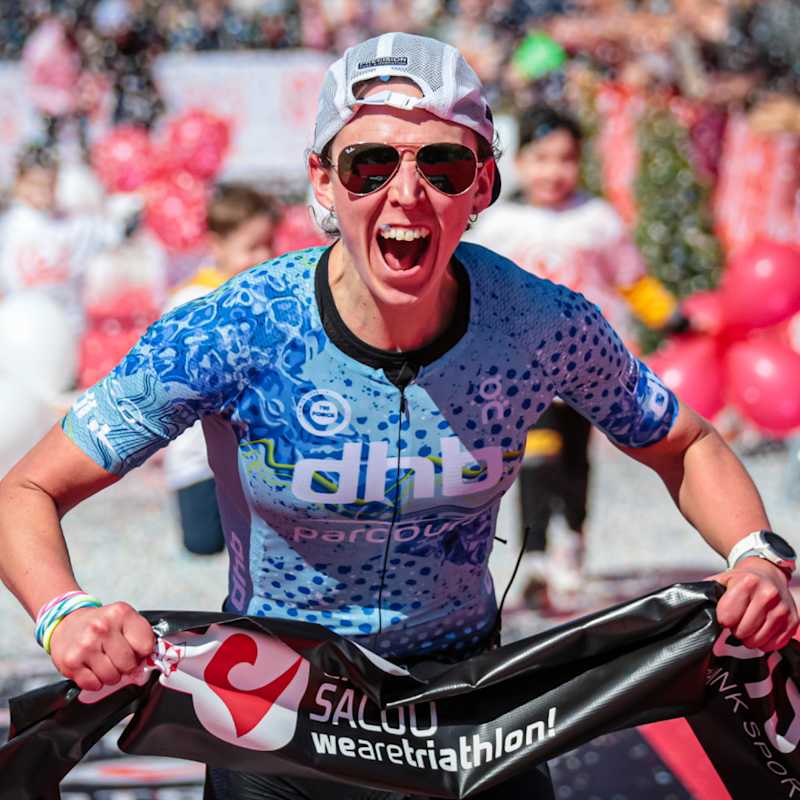
Fenella Langridge
IRONMAN® South Africa
Fenella's headline numbers
Fenella's strategy
Fueling
Carbohydrate is the main fuel you burn when racing. Failing to fuel properly is a leading cause of underperformance in longer races.
Unfortunately, during the bike leg Fenella lost two of her primary fuel bottles which contained two PF 90 Gels. Without specific knowledge of what the on-course aid station bottles contained, she was unsure what her carb intake would be so she planned to reduce her effort level slightly to avoid “bonking” later on in the race. This coincided with some fluctuating perception of her energy levels, which took a few hours to stabilise. Fenella still had a couple of PF 90 Gels, PF 30 Caffeine Gels and a pack of PF 30 Chews with her that helped to keep a consistent flow of energy coming in, but with the loss in bottles she only managed to hit 61% of her pre-race carb goal. Thankfully, as Fenella hopped off the bike and began the attempt to catch up on her fueling, she actually felt her energy levels regain some consistency. With the unpredictable likelihood of losing fuel during a race, Fenella managed her energy levels well and took on fuel when she could to race strong until the finish.
Hydration
Taking on board an appropriate amount of fluid and sodium is essential to maintaining blood volume and supporting the cardiovascular effort needed to perform on race day.
Whilst the absolute amount of sodium and fluid consumed per hour is important, it’s critical to consider these in relation to each other. This is known as 'relative sodium concentration' and it’s expressed in milligrams per litre (mg/L). How much sodium you’re taking in per litre of fluid is more important than the absolute amount taken in per hour.
Sweat sodium concentration (mg/L) is largely genetically determined and remains relatively stable. Knowing how salty your sweat is enables you to replace a good proportion of your sweat losses, which can range from 200-2,000mg/L.
Given Fenella’s losses are High (1,331mg/L), nailing her hydration strategy becomes especially crucial when it’s hot and/or humid.
Learn moreThe loss of bottles didn’t just affect her carb intake, as some of her planned sodium was in the bottles, too. Whilst she did her best to pick up the on-course sports drinks from the aid stations, replacing some of the fluids she’d dropped, her total fluid intake was still below what she’d hoped to consume. Despite this, she stuck to her pre-planned strategy to take on 18 Electrolyte Capsules, which meant her relative sodium concentration was slightly higher than her losses. In an ideal world, Fenella would have increased the amount of fluid picked up from aid stations to keep the concentration of her drinks more in line with her sweat losses, but she navigated a tricky situation well and stayed on track overall.
Caffeine
Beyond the Three Levers of Performance (carb, sodium and fluid), caffeine is one of only a few substances that is proven to improve performance for most endurance athletes as it can help stave off mental and physical fatigue.
Fenella has always used caffeine to aid her performance, as she knows it reduces her perception of effort whilst racing, especially towards the end when things start to get tough. This race was no exception, as she consumed around 9 milligrams per kg across the race. This is slightly above the recommended dose for endurance performance, but is a quantity we’ve seen Fenella take comfortably at previous races.
How Fenella hit her numbers
Here's everything that Fenella ate and drank on the day...
Fenella's weapons of choice
Final thoughts
Fenella's full stats
Data Confidence?
There is some confidence in the quantities and brands of products consumed but the data may lack specifics (e.g. volumes specific flavours). A high number of estimations have been made and the room for error is moderate-high. There may also be the possibility that some intake has been grossly over- or under-estimated.